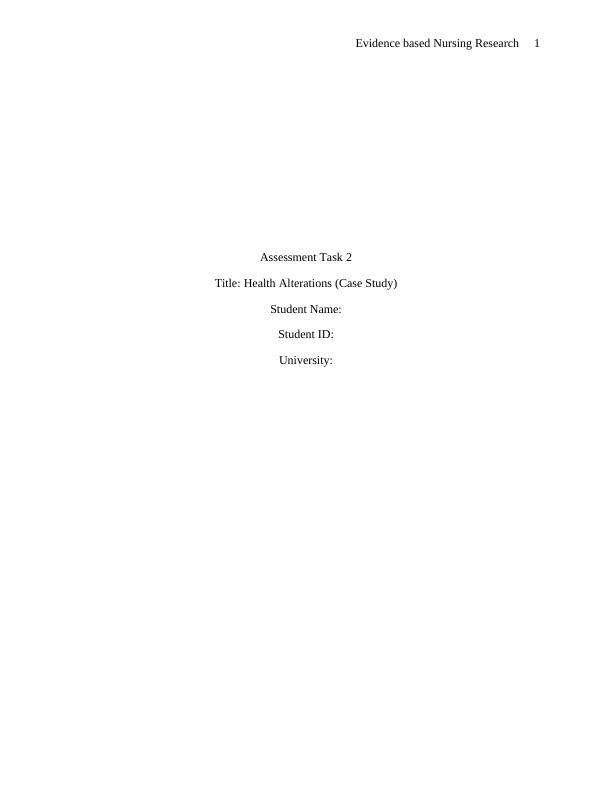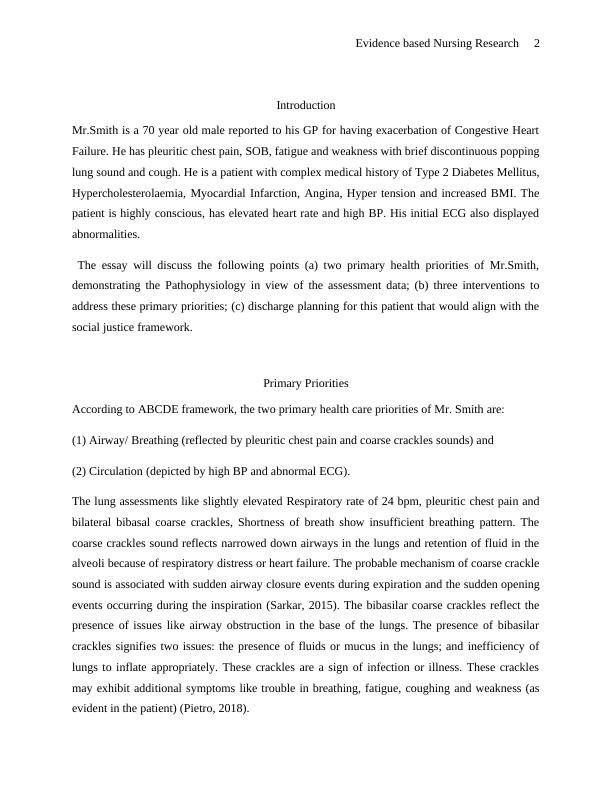Evidence based Nursing Research
Added on 2023-01-19
9 Pages2848 Words98 Views
Evidence based Nursing Research 1
Assessment Task 2
Title: Health Alterations (Case Study)
Student Name:
Student ID:
University:
Assessment Task 2
Title: Health Alterations (Case Study)
Student Name:
Student ID:
University:

Evidence based Nursing Research 2
Introduction
Mr.Smith is a 70 year old male reported to his GP for having exacerbation of Congestive Heart
Failure. He has pleuritic chest pain, SOB, fatigue and weakness with brief discontinuous popping
lung sound and cough. He is a patient with complex medical history of Type 2 Diabetes Mellitus,
Hypercholesterolaemia, Myocardial Infarction, Angina, Hyper tension and increased BMI. The
patient is highly conscious, has elevated heart rate and high BP. His initial ECG also displayed
abnormalities.
The essay will discuss the following points (a) two primary health priorities of Mr.Smith,
demonstrating the Pathophysiology in view of the assessment data; (b) three interventions to
address these primary priorities; (c) discharge planning for this patient that would align with the
social justice framework.
Primary Priorities
According to ABCDE framework, the two primary health care priorities of Mr. Smith are:
(1) Airway/ Breathing (reflected by pleuritic chest pain and coarse crackles sounds) and
(2) Circulation (depicted by high BP and abnormal ECG).
The lung assessments like slightly elevated Respiratory rate of 24 bpm, pleuritic chest pain and
bilateral bibasal coarse crackles, Shortness of breath show insufficient breathing pattern. The
coarse crackles sound reflects narrowed down airways in the lungs and retention of fluid in the
alveoli because of respiratory distress or heart failure. The probable mechanism of coarse crackle
sound is associated with sudden airway closure events during expiration and the sudden opening
events occurring during the inspiration (Sarkar, 2015). The bibasilar coarse crackles reflect the
presence of issues like airway obstruction in the base of the lungs. The presence of bibasilar
crackles signifies two issues: the presence of fluids or mucus in the lungs; and inefficiency of
lungs to inflate appropriately. These crackles are a sign of infection or illness. These crackles
may exhibit additional symptoms like trouble in breathing, fatigue, coughing and weakness (as
evident in the patient) (Pietro, 2018).
Introduction
Mr.Smith is a 70 year old male reported to his GP for having exacerbation of Congestive Heart
Failure. He has pleuritic chest pain, SOB, fatigue and weakness with brief discontinuous popping
lung sound and cough. He is a patient with complex medical history of Type 2 Diabetes Mellitus,
Hypercholesterolaemia, Myocardial Infarction, Angina, Hyper tension and increased BMI. The
patient is highly conscious, has elevated heart rate and high BP. His initial ECG also displayed
abnormalities.
The essay will discuss the following points (a) two primary health priorities of Mr.Smith,
demonstrating the Pathophysiology in view of the assessment data; (b) three interventions to
address these primary priorities; (c) discharge planning for this patient that would align with the
social justice framework.
Primary Priorities
According to ABCDE framework, the two primary health care priorities of Mr. Smith are:
(1) Airway/ Breathing (reflected by pleuritic chest pain and coarse crackles sounds) and
(2) Circulation (depicted by high BP and abnormal ECG).
The lung assessments like slightly elevated Respiratory rate of 24 bpm, pleuritic chest pain and
bilateral bibasal coarse crackles, Shortness of breath show insufficient breathing pattern. The
coarse crackles sound reflects narrowed down airways in the lungs and retention of fluid in the
alveoli because of respiratory distress or heart failure. The probable mechanism of coarse crackle
sound is associated with sudden airway closure events during expiration and the sudden opening
events occurring during the inspiration (Sarkar, 2015). The bibasilar coarse crackles reflect the
presence of issues like airway obstruction in the base of the lungs. The presence of bibasilar
crackles signifies two issues: the presence of fluids or mucus in the lungs; and inefficiency of
lungs to inflate appropriately. These crackles are a sign of infection or illness. These crackles
may exhibit additional symptoms like trouble in breathing, fatigue, coughing and weakness (as
evident in the patient) (Pietro, 2018).

Evidence based Nursing Research 3
The auscultation assessment of lungs can reveal the abnormal coarse crackles which are brief,
discontinuous and popping sounds. They are lower in pitch, louder and stay for longer. It shows
presence of excessive lungs inside the lungs. In this patient, the crackles are caused by transudate
like congestive heart failure and pulmonary edema.
Intense pleuritic chest pain occurs in the chest during inhale and exhale (Thim, Krarup, Grove,
Rohde and Løfgren, 2017). It occurs due to swelling of parietal pleura which causes pain in
cutaneous distributions of these nerves. The patient may have swelling in the membranes
surrounding the lungs and the linings of chest cavity. The nerves may disseminate the pain to the
shoulders and neck regions as well. In this patient the probable cause of pain can be Myocardial
Infarction (Sarkar, Madabhavi, Niranjan and Dogra, 2015). The symptoms of pain may be
accompanied with the other symptoms like SOB, faster Heart rate, shallow breathing and dry
cough. Another possible reason for the pleuritic chest pain is filling up of the space between the
pleurae with fluid. It causes SOB as the lungs need space for expanding during the breathing
(Thim et al., 2017).
The Circulatory problems are depicted by high BP, high heart rate, abnormal ECG, hypertension,
increased BMI, low level of SpO2 and hypercholesterolemia. Though he is fully conscious, his
low SpO2 reveals low level of hemoglobin carrying oxygen.
These care priorities can be addressed using Pharmacological Therapies, Non Pharmacological
Therapies and Use of Mechanical Circulatory Devices like Ventricular Assist Devices (VADs).
Interventions
The interventions for treatment and management of congestive heart failure may be aimed to
improve the cardiac function, breathing and symptom management. The treatment goals of the
pleuritic chest pain can be to provide relief from the symptoms, elimination of fluids, blood or air
from the pleural space, and the treatment of underlying symptoms.
Pharmacological Therapy
The auscultation assessment of lungs can reveal the abnormal coarse crackles which are brief,
discontinuous and popping sounds. They are lower in pitch, louder and stay for longer. It shows
presence of excessive lungs inside the lungs. In this patient, the crackles are caused by transudate
like congestive heart failure and pulmonary edema.
Intense pleuritic chest pain occurs in the chest during inhale and exhale (Thim, Krarup, Grove,
Rohde and Løfgren, 2017). It occurs due to swelling of parietal pleura which causes pain in
cutaneous distributions of these nerves. The patient may have swelling in the membranes
surrounding the lungs and the linings of chest cavity. The nerves may disseminate the pain to the
shoulders and neck regions as well. In this patient the probable cause of pain can be Myocardial
Infarction (Sarkar, Madabhavi, Niranjan and Dogra, 2015). The symptoms of pain may be
accompanied with the other symptoms like SOB, faster Heart rate, shallow breathing and dry
cough. Another possible reason for the pleuritic chest pain is filling up of the space between the
pleurae with fluid. It causes SOB as the lungs need space for expanding during the breathing
(Thim et al., 2017).
The Circulatory problems are depicted by high BP, high heart rate, abnormal ECG, hypertension,
increased BMI, low level of SpO2 and hypercholesterolemia. Though he is fully conscious, his
low SpO2 reveals low level of hemoglobin carrying oxygen.
These care priorities can be addressed using Pharmacological Therapies, Non Pharmacological
Therapies and Use of Mechanical Circulatory Devices like Ventricular Assist Devices (VADs).
Interventions
The interventions for treatment and management of congestive heart failure may be aimed to
improve the cardiac function, breathing and symptom management. The treatment goals of the
pleuritic chest pain can be to provide relief from the symptoms, elimination of fluids, blood or air
from the pleural space, and the treatment of underlying symptoms.
Pharmacological Therapy

End of preview
Want to access all the pages? Upload your documents or become a member.
Related Documents
Case Study: Nursing Care for CHF Exacerbation in an Elderly Patientlg...
|11
|3122
|67
Mr. Smith’s Case Studylg...
|7
|3062
|89
Health and Social Care Sectorlg...
|13
|2369
|402
Case Study on Congestive Heart Failurelg...
|11
|3229
|27
Health Alterationlg...
|12
|2630
|424
Electrocardiogram (ECG)lg...
|6
|1382
|134
